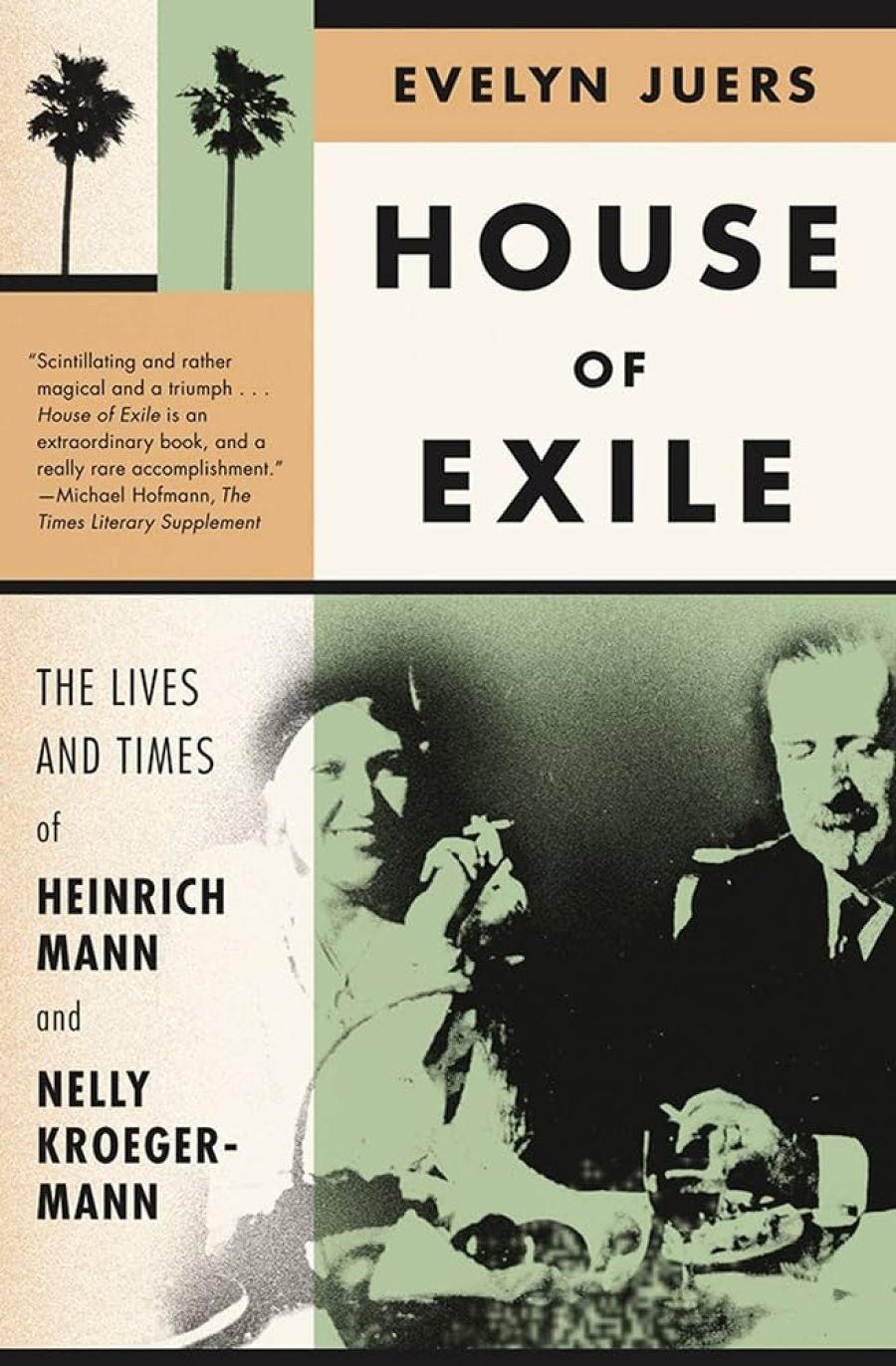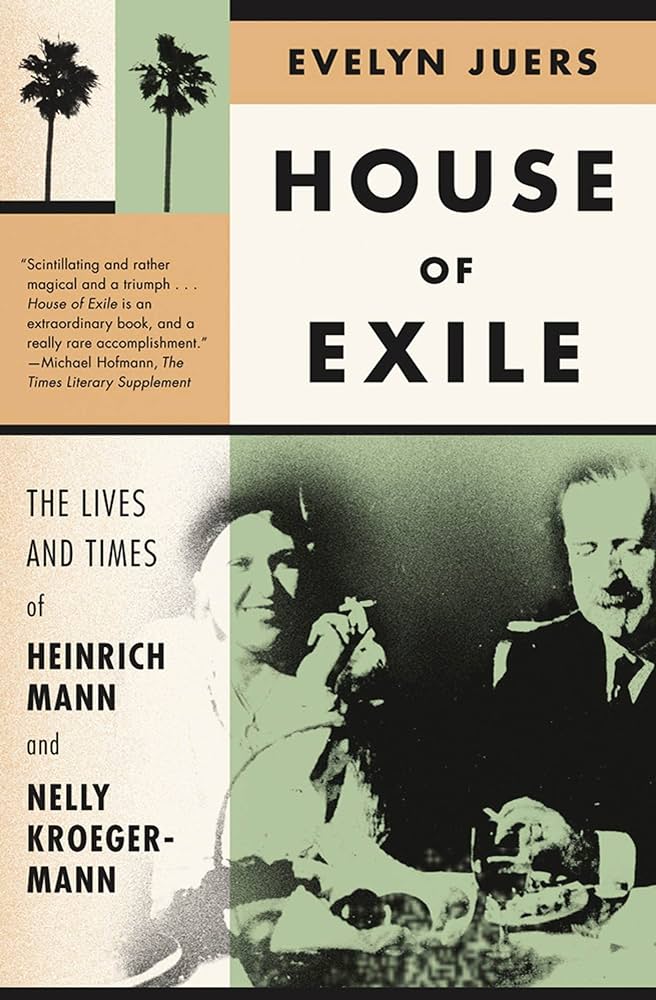
- Free Article: No
- Contents Category: Biography
- Review Article: Yes
- Article Title: The Brothers Mann
- Article Subtitle: Gems and liberties in a collective biography
- Online Only: No
- Custom Highlight Text:
Evelyn Juers’s wide-ranging and suggestive study of Heinrich Mann (older brother of Thomas) and his second wife, Nelly Kroeger-Mann, opens with a vivid extended anecdote, recounting a meeting between the couple and Bertolt Brecht at a fruit market in Los Angeles, in the summer of 1944. Members of the community of European exiles in Los Angeles had flocked to the market because a farmer ‘was selling berries … Not just strawberries, blueberries … [but] also … gooseberries’. Jokingly translating the English word into Gaensebeeren (the actual German is Stachelbeeren), Brecht is caught handing out ‘a great mound of amber fruit’, giving Heinrich and Nelly ‘a translucent gem to taste’, and wittily punning ‘that he was no gooseberry fool’.
- Book 1 Title: House Of Exile
- Book 1 Subtitle: The Life and times of Heinrich Mann and Nelly Kroeger-Mann
- Book 1 Biblio: Giramondo, $32.95 pb, 384 pp
- Book 1 Cover Small (400 x 600):

- Book 1 Cover (800 x 1200):

The only problem with this page-long paragraph, lively and evocative though the writing may be, is the (perhaps) mundane question: did it actually happen? There is no record of it in either Werner Hecht’s 1300-page exhaustive chronicle of Brecht’s life and times, nor in the definitive work on his years in America, James K. Lyon’s Bertolt Brecht in America (1980), which is cited in Juers’s nine-page bibliography. (Professor Lyon confirms that the incident is entirely unknown to him, and somewhat unlikely.) It may be that Juers has come across it in her extensive research into other sources: if so, I suspect I am not the only one who would like it precisely identified.
I can imagine readers murmuring to themselves: does this really matter? Do we really need, in this ‘collective biography’ (the author’s term) every ‘i’ dotted, every ‘t’ crossed? Is this not tedious academic pedantry? Are not the boundaries between the documented and/or carefully reconstructed details of someone’s biography and Juers’s synthetic, syncretic approach, which offers a creative imagining of the subjects’ lives and personalities, much more fluid these days? Perhaps – or perhaps not.
When I read that ‘the Californian sun glinted from [Brecht’s] glasses like the sword of Zorro’, or, one hundred pages later, of his ‘devilish cigar’, I start wondering whether we are in the world of Johnston McCulley and Zane Grey (each fine, in his own way) rather than Michael Holroyd, Richard Ellmann or Ronald Hayman, all distinctive yet more traditional biographers. As Mary Beard puts it, in a recent London Review of Books review of a biography of Marcus Aurelius: ‘It is surely the job of all biographers to explain what lies behind their own reconstruction of their subject’s life; biography is always as much about how we know as what’ (23 July 2009).
Juers might well argue that she is not primarily interested in ‘traditional’ biography, but while there is a place for the creative reimagining of incidents and experiences in a subject’s life, this is not the same as the often tedious tasks of confirming details, tracking down biographical and personal data, filleting the available sources, and presenting the reader with an account that allows him or her to see clearly where the factual gaps are and how they have been filled.
Not that Juers’s approach to, and command of, her sources is cavalier. She has come up with some fascinating and compelling details, such as locating the daughter of Nelly’s early love, Rudolf Carius, and a surviving American nephew, as well as instructive clues about the connections between Nelly and her close friend Salomea Rottenberg; along with the information that Walter Benjamin’s son Stefan was shipped to Australia on the Dunera, moved to the United States after his release in December 1941, and subsequently managed an antiquarian bookshop opposite the British Museum (which I seem to remember visiting in the mid-1960s, entirely ignorant of the owner’s genealogy).
But hand in hand with such isolated trouvailles runs an approach to contextualising her, one assumes, primary narrative within a wealth of incidental detail, which seems to have been inserted without any clear or implicit rationale for its selection. To give one instance: we learn that the 1935 Parisian summer was notable for many writers who felt that writing ‘really was a form of political action’; that, back from a holiday, Virginia Woolf ‘found that she was unable to work’; that ‘Thomas and Katia [sic., recte Katja] Mann returned to Europe on the Cunard liner Berengaria’, with the author thinking that ‘sea air was good for him … as always it stirred his libido’; that the queen of Belgium died; that (chez Woolf) ‘blackberries ripened, but there were no mushrooms’; and finally – surely the most relevant information in a study of Heinrich Mann – that his novel Henri IV was published, and it took his brother three weeks to read it.
The problem with this sort of unmediated accumulation of information is that it comes perilously close to biography by shopping list. Is, for example, learning that Virginia Woolf watched a kingfisher fly across a river especially relevant for anyone wishing to learn about Heinrich and Nelly’s life, and why they matter to the author? In particular – at least for this reader – the constant intrusion into the narrative of Virginia and Leonard, along with details of their, by comparison, privileged and comfortable existence in Sussex, or their motoring holiday through Holland with their marmoset, is not just irrelevant but wearisome. Earlier in the book, Juers makes ingenious use of a holiday the Woolfs took in Berlin in the winter of 1929, to evoke a different set of reactions to the metropolis from those usually associated with that city of cabarets, cafés, theatres, tenements and assorted bohemian activities (elsewhere referred to, in a rather perfumed phrase, as its ‘sequined resonance’). But Virginia’s impressions of the city hardly match those of, say, Joseph Roth or Erich Kaestner for sharpness or suggestiveness: for her it is an ‘immeasurably mediocre place, too sprawling, ugly, cold and nasty’ (one can almost see her delicate Bloomsbury nostrils quivering with disdain), an impression presumably confirmed by the expedition undertaken on their last day to satisfy Leonard’s voyeuristic wish ‘to see one of the poorer suburbs’.
At this point in the book, the reader can infer from the context a certain justification for the introduction of the Woolfs into the narrative. By the time Virginia has reappeared for the nth time (‘In July Heinrich and Nelly stayed in the spa and lavender town of Digne, near Grenoble … Virginia wrote letters, cooked dinner and did her embroidery …’), one’s puzzlement at the (lack of) connection – this is surely a case of elective affinities at their most contrived – is matched only by impatience at the interruption to the central narrative and the resulting shunting of the major characters off into the wings.
These days, the life and work of Heinrich Mann is, alas, little known outside Germany. Apart from the film The Blue Angel (1930), based on his best-known novel, and a brilliant adaptation for British television of Der Untertan (1918), entitled Man of Straw, and featuring Derek Jacobi in an unforgettable realisation of that particular German character type that combines obsequiousness with an inflated sense of superiority, the English-speaking world continues to pay more attention to the author of The Magic Mountain (1924). Juers’s commendable intention of correcting this imbalance is to be applauded: but at the end of the book, I still felt I had relearned more than I ever wanted to know about brother Thomas’s bowels, hypochondria, repressed homosexuality (all familiar since the 1975 publication of his exhausting and exhaustive diaries) and lolly bags of sleeping pills.
Heinrich was always a more politically committed and engaged writer than his brother: back in the 1960s, the critic Henry Hatfield noted: ‘It is hard to realize today that Heinrich Mann … was once considered more important and “modern” than his younger brother … Doubtless his prestige was exaggerated, but the reaction against it has gone too far.’ Unlike Thomas, Heinrich’s situation and status in exile was far more precarious and difficult, though Thomas did provide him with financial and other means of support.
But the relationship between the two families had to contend with the problem of Nelly, and it is here that one feels that Juers’s wish to redress what she sees as unfair depictions of Nelly leads her to some odd and often unsupported attempts at re-evaluation. Nelly’s background, solidly investigated and summarised by the author, was completely different from her husband’s: she had worked as a barmaid, and in cabarets, was twenty-six years younger than he, voluptuous, sensual and given at times to unpredictable scenes. For whatever reason, she drank too much, and had attempted suicide on previous occasions before, sadly, she succeeded, leaving Heinrich devastated.
It is surely unfair of Juers to gloss Martha Feuchtwanger’s comment on Nelly (‘The most remarkable thing about her was Heinrich Mann’s extraordinary love for her’) as ‘ungracious’. For any number of reasons, the relationship was vitally important to both Nelly and Heinrich, and for all Juers’s sympathy for Nelly she sometimes misses the opportunity to allow the reader to share this. Often I found myself wishing that she would have allowed Nelly to speak in her own words (letters, diary entries, etc.) rather than paraphrasing them, so that one might get a clearer – in this case definitely unmediated – sense of the subject’s voice and personality.
Nevertheless, Juers’s far-reaching survey of the couple’s life and times, and her judicious pen-portraits of a supporting cast of friends, writers, performers and commentators who were also driven out by the Nazis, show an impressive ability to move from the general to the particular and back. If the study prompts the reader to seek out the writings of Heinrich Mann (or Joseph Roth, Alfred Döblin or even Theodor Fontane), so much the better. But in the case of the last-named, it would be advisable first to correct Juers’s spelling of his greatest novel, frequently referred to in her text. For, along with disconcerting misspellings such as Moericke, Macauley, Nabokov and Zuckmeyer, Fontane’s masterpiece is written throughout as Effie Briest – an error as egregious as writing, say, Emmie Bovary or Dombie and Son.


Comments powered by CComment